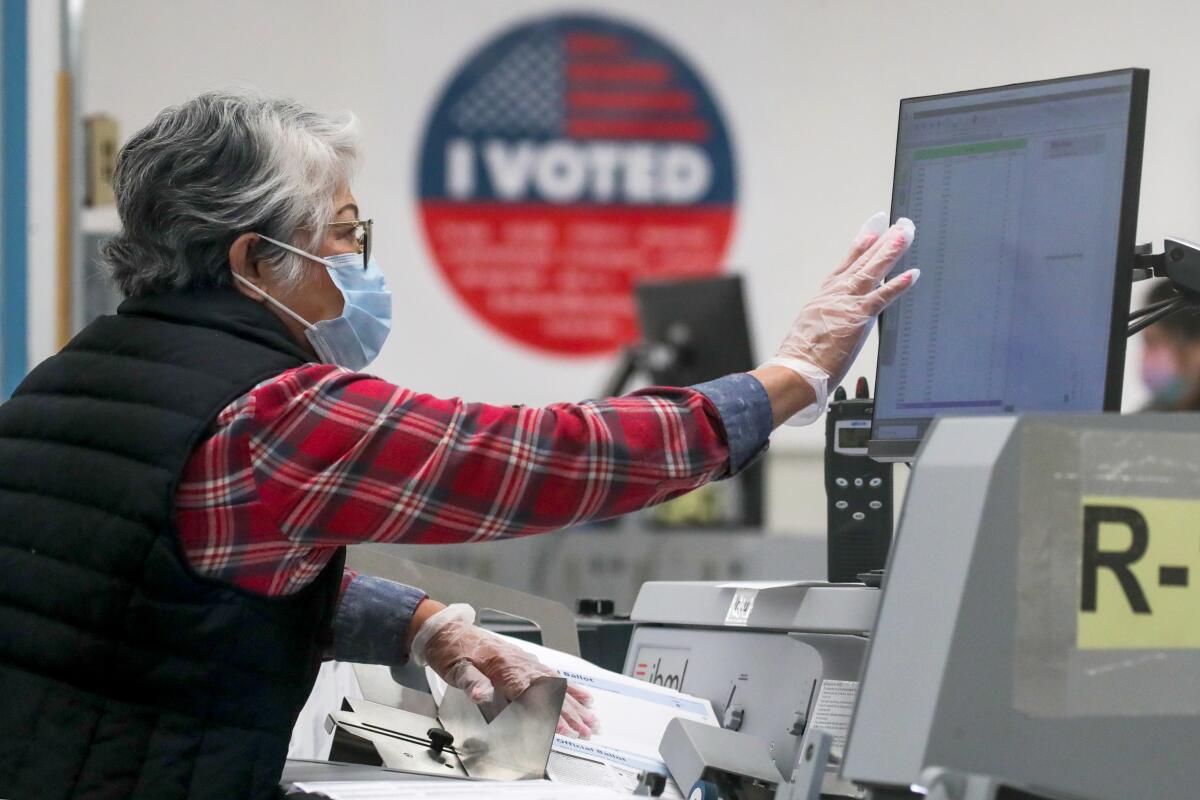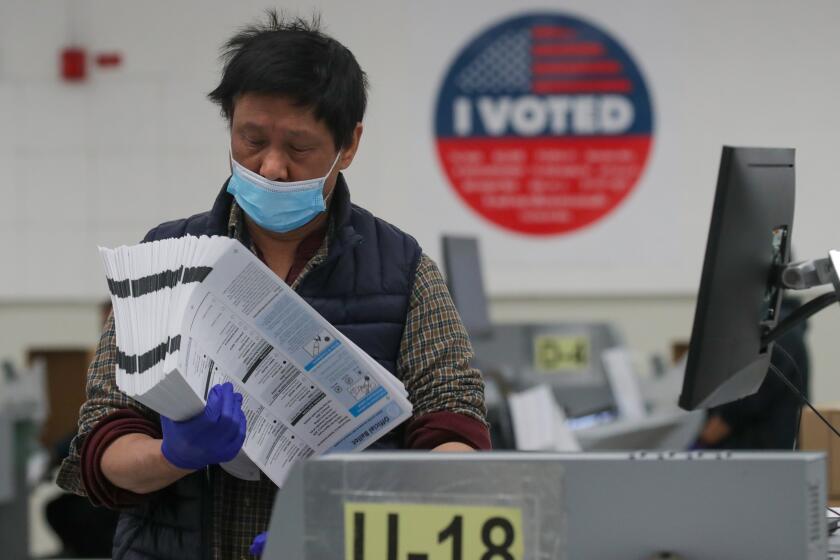Both parties had high hopes for California in the midterms. Neither saw its dreams fully come true

- Share via
The battles for California’s most competitive congressional races have effectively ended in a draw after months of campaigning and more than $100 million in advertising. Neither Democrats nor Republicans have so far ousted an incumbent or won new ground in their opponent’s territory.
Each party had higher aspirations this cycle than a continuation of the status quo. Democrats saw California as a beacon — a rare opportunity to play offense in a season that appeared increasingly ominous. Republicans, giddy with confidence of an easy takeover of the House majority, sensed an opportunity to run up the score in the state’s blue-tinted districts.
Though neither side’s best-case scenario came to pass, both say there were bright spots to be found in the stalemate.
For Democrats, it was triumphing over the factors stacked against them: President Biden’s subpar approval ratings, which dipped underwater even in solidly blue California; persistent inflation; and precedent that cut against the party holding the White House.
“If you compare the result to the height of Democratic optimism, it feels like a great disappointment,” said Democratic strategist Rose Kapolczynski. “If you compare the result to historical performance in midterms, it’s a minor miracle.”
Republicans say they succeeded by capitalizing on opportunities left by retiring Democrats, helping incumbents fend off right-wing challenges in the primary and tying up Democrats’ dollars with their ambitious forays into liberal territory.
In the midterm election, California swayed control of Congress and the last races added to Republicans’ margin of power. Here’s where House races stand.
“We expanded the map outwards. We took bets on some tough-to-win seats that Biden won by double digits — the majority of which we won, and others we came very close in,” said Calvin Moore, spokesman for the Congressional Leadership Fund, the super PAC affiliated with House Republican leader Kevin McCarthy. “As a result, Democrats were forced out of very close contests — races they probably could’ve won — while giving us a shot to win additional seats.”
The national trends that enabled Democrats to keep the Senate and limit the GOP to a single-digit majority in the House were evident in the congressional races in California, said Dan Schnur, who teaches political communications at USC and UC Berkeley.
“The election ended up being a decision over which issue was more important — inflation or abortion,” Schnur said. “And just as we saw in other parts of the country, this election ended up not being a referendum on the incumbent president, but a choice between Joe Biden and Donald Trump.”
In California, however, those dynamics were shaped by the state’s idiosyncrasies, creating some stark contrasts with how the midterm played out across the country.
The Supreme Court decision overturning federal protections for abortion rights scrambled the political mood here as it did elsewhere. Abortion rights advocates responded with Proposition 1, an initiative to enshrine abortion protections in California’s Constitution. It ended up the top vote-getter on the ballot, outperforming Gov. Gavin Newsom and Sen. Alex Padilla.
The success of Proposition 1 was in part due to what proponents call “surge Democrats,” who would not have voted if not for the abortion issue. But the measure also clearly appealed to voters across the political spectrum, including people who voted down-ticket for Republicans. As a result, Democrats did not see the same electoral boost in California congressional races as they did in states where abortion rights are more threatened, such as Michigan.
“The question before [voters] was, ‘Do you want abortion rights protected?’ Overwhelmingly, the answer was yes,” said Jodi Hicks, president of Planned Parenthood California. But, she said, advocates need to continue emphasizing that even though abortion access has safeguards in the state, “without federal protection, we’re always a national ban away from losing our rights.”
California Republicans largely sidestepped a different national phenomenon: nominating candidates too closely associated with Trump. Contenders endorsed by the former president cost the GOP winnable races in districts previously held by moderate Republicans in states such as Michigan and Washington.
The Bakersfield congressman’s ideological flexibility, fundraising prowess and management of Donald Trump have helped him hold House Republicans together as they head into the midterm elections. Now he’s on the verge of gaining the prize he has long desired.
While Trump’s specter still loomed over the party as a whole, Republican politicians in California kept him at a greater distance than those in other states.
“That’s the kind of candidate recruitment that as a party we have to look at nationally,” said Tom Ross, a Republican consultant who advises McCarthy. “I think we get that here in California. ... We don’t get that at a national level.”
He pointed to a quartet of GOP incumbents — Reps. Young Kim and Michelle Steel of Orange County, Mike Garcia from northern Los Angeles County and David Valadao of the Central Valley — as the types of candidates his party should boost nationwide.
Democrats, bracing for losses elsewhere, saw those House members as enticing targets. Under the new congressional map drawn during the redistricting process last year, nearly half of the state’s GOP incumbents saw their districts grow more blue. Steel, Valadao and Garcia appeared on paper to be especially vulnerable.
Given the makeup of the districts, any Republican further to the right of the incumbents would almost certainly lose the seat. During the primary, the Congressional Leadership Fund spent nearly $1 million on advertising to protect Kim, who faced a right-wing challenger. The group also spent roughly $500,000 on air for Valadao, who was challenged by two fellow Republicans angered by his vote to impeach Trump.
Ultimately, Kim, Garcia and Steel comfortably won reelection. Valadao’s victory over Democratic Assemblyman Rudy Salas became official on Monday, nearly two weeks after election day.
Democrats were also successful in defending incumbents in close House races: Mike Levin defeated former San Juan Capistrano Mayor Brian Maryott, and Katie Porter narrowly beat Scott Baugh, a former state assemblyman.
The wins by incumbents illustrate how our rigidly polarized political landscape leads to fewer wild swings between the parties, said Lynn Vavreck, a political science professor at UCLA.
“That, to me, is a reflection of how settled and divided and separated this moment in politics is in America. It’s not just California; it’s happening everywhere,” Vavreck said.
As a result, the glide path McCarthy envisioned to the speaker’s gavel was far more of a grind. Without a red wave, the Bakersfield Republican now faces a narrow, fractious majority and a rocky road to the speakership. Nevertheless, it was a victory in his home state — Garcia’s win in the 27th District — that clinched the House majority.
That race was one of the biggest missed opportunities for Democrats. Garcia had won by just 333 votes two years ago, and his district became even less Republican after redistricting. His objection to the full counting of the 2020 electoral votes risked alienating his constituents, and national Democrats signaled early that they planned to capitalize on that.
Instead, neither the Democratic Congressional Campaign Committee nor the House Majority PAC, the super PAC affiliated with Speaker Nancy Pelosi, spent money on broadcast television in the pricey Los Angeles market. The lack of air support hobbled Garcia’s opponent, Christy Smith, and other Democratic candidates in the L.A. area seeking to oust GOP incumbents.
The cost-benefit analysis is nothing new, said Bill Carrick, a veteran strategist, who recalled a similar calculus when he worked for the Democratic Congressional Campaign Committee in 2000.
“You always get to this final thing where you say, ‘Do we really want to buy time in the L.A. media market for congressionals?’ because it’s going to cost a fortune,” Carrick said.
Another closely watched race — California’s 13th District in the Central Valley — remained uncalled as of Monday evening. Voters in the open district went for Biden by 11 percentage points in 2020, and Democrats have a substantial advantage in voter registration there. Still, GOP candidate John Duarte, a farm owner, is neck-and-neck with Democratic Assemblyman Adam Gray. If Duarte wins, it will be the GOP’s most successful push this cycle into blue territory in the state.
Get our L.A. Times Politics newsletter
The latest news, analysis and insights from our politics team.
You may occasionally receive promotional content from the Los Angeles Times.
Despite Republican encroachment, however, Democratic operatives say they are confident that their party will fully capitalize on the advantages of the redrawn districts in the next election cycle.
“Redistricting is a long-term play, and I think these districts show that in presidential years, Democrats are going to have a much stronger outcome,” said Bill Burton, who was a White House spokesperson for President Obama and now lives in California. “If I were Kevin McCarthy, I would not be unpacking every single box in the speaker’s office. I think his tenure is going to be short-lived.”
Both parties also found upsides in some of their closest defeats.
Republican consultant Kevin Spillane said the narrowness of the GOP losses to Democrats Porter and Levin could point to future success in those districts with different candidates.
“You’ve got two white males who are not articulating pro-choice, socially moderate views,” Spillane said of the GOP candidates. “It makes it a more challenging race. The fact they still got close is a source of encouragement to me. In the long term, I think we can win those seats.”
First-time Democratic candidate Will Rollins nearly toppled longtime GOP Rep. Ken Calvert in Riverside County. The seat got tougher for Calvert in redistricting, giving Democrats a registration advantage of less than 1%. Voters there narrowly backed Trump in 2020.
“The congressman always knew it was going to be competitive,” said Jason Gagnon, a Calvert spokesman. “Anytime you have a race this narrowly divided, it’s going to come down to just a few thousand votes one way or the other.”
Rollins’ strong showing earned him praise from other Democrats, who widely expect he’ll seek the seat again in two years.
“We had the best midterm performance any challenger has ever had, and I think there’s no doubt [Calvert] will be beaten in ’24,” Rollins said. Stopping just short of committing to another run, he referenced a former governor he had worked for fresh out of college.
“As my former boss Arnold used to say, ‘I’ll be back,’” Rollins said. “But in my case, I’d say probably.”
More to Read
Get the L.A. Times Politics newsletter
Deeply reported insights into legislation, politics and policy from Sacramento, Washington and beyond. In your inbox twice per week.
You may occasionally receive promotional content from the Los Angeles Times.















